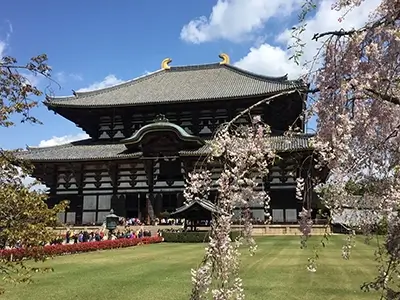The Todaiji temple is located in the famous Nara Park in Nara, Japan. It is famous as the world’s largest wooden structure. Let’s learn a bit more about its long history!


Todaiji History
The origins of the Tōdaiji lie in a temple called Kinshō-ji. This temple was founded in 728 for the repose of the spirit of Crown Prince Motoi, son of Emperor Shōmu. In 741, when the Emperor ordered the construction of a national system of monasteries, the Kinshō-ji received a higher status. In 743 Emperor Shōmu asked for the building of a Great Buddha Image. And when the capital was returned to Heijō (Nara), construction of the colossal image of Vairocana begun. The statue was constructed on the grounds of the Kinkōmyō-ji and was completed in 749.
Construction of the Great Buddha Hall took place at the same time and the image was dedicated in 752 with a lavish consecration ceremony. According to records kept by Tōdai-ji, more than 2,600,000 people in total helped construct the Great Buddha and its Hall. Contributing rice, wood, metal, cloth, or labor, with 350,000 people working directly on the statue’s construction.
Temple Restauration
In 1180, more than half of the compound including the Great Buddha Hall was destroyed in a fire. The fire resulted from the attack on the Nara temples by the Taira clan. In the next year, the restoration of the temple was started by monk Chōgen, and in 1185 the Great Buddha was consecrated. In the following year, what is now Yamaguchi prefecture was appointed to provide income for the reconstruction of Tōdai-ji. At that time, the tempo of the work went up.
Ten years later the Great Buddha Hall was completed. As the temple was finished, learning activities that had not been happening were also revived. And during the Kamakura period (1185-1333) the temple raised many scholar-monks.
The start of the Meiji period in 1868 saw the separation of Shinto and Buddhist religious institutions. At this point, the taking of temple lands by the government threatened the existence of Tōdai-ji. Still, the temple managed to carry out large repairs to the Great Buddha Hall at the start of this century and again in the 1970s, and has worked hard to preserve the extensive compound with all its structures.
Tōdai-ji today preserves many precious cultural treasures from the temple’s past, and it also is a treasure house of traditional Buddhist rituals. Many people from within Japan and the world visit the temple to worship and pay their respects every year.
A Personal Impression
Tōdaiji Temple is well known as one of the most iconic sites in Nara, but seeing the Great Buddha in person gave me a different impression than I expected. The scale of the statue and the quiet inside the main hall left a strong impression.
The temple grounds were open and peaceful, with deer wandering around as usual. Even though it’s a popular spot, the atmosphere felt calm. It’s a place where you can slow down and take your time.
Recommended Tours
・The Best of Japan Private Tour Package 7 Days
・2025 The Classic Japan Tour package 8 Days
・8-Day Small Group Tour Golden Route Japan in Cherry Blossoms Season
Your Japan Tour
As seasoned Japan experts, we create perfect Japan package tours including destinations like Nara. Check out our group tours and private tours, or contact us to start planning your unforgettable holiday to this fascinating country. Japan is full of once-in-a-lifetime experiences, culture, history, nature, and delicious food!
Access Information
Access: Kintetsu-Nara or JR-Nara station, or Himurojinja-Kokuritsuhakubutsukan bus stop
Entrance fee: Adults 600 yen, elementary students 300 yen
Hours: April to October: From 7.30 am to 5.30 pm (last entry 5 pm) / November to March: From 8 am to 5 pm (last entry 4.30 pm)